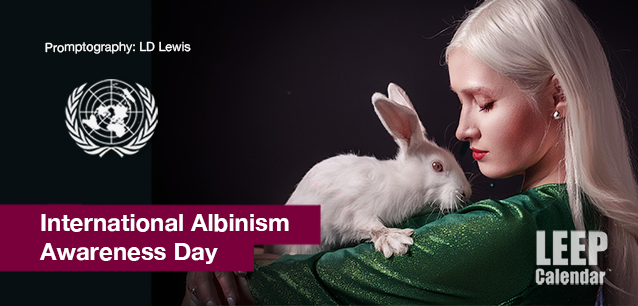 AD
AD
Today is: September 20
Scroll to explore events active on this date.
Additional Events on LEEP
LEEP INK FEATURES

July is a Jubilee of Events
This sign in a store window in Dublin gave me a good laugh! At 18, we're all geniuses. By 30, we realize we're idiots! Photo LD Lewis July is a Jamboree of Events! Happy July. Like every month, I pick...

June 2024 Gems
June's Gems Welcome to June. School is out, fun is in, and business tends to slow down for the next three months. Another June theme is children and keeping them engaged, learning and growi...

Momentous May Events
Prom, graduation, mothers, boating and barbeques are several themes in May. Along with October, May tends to be one of the most densely packed event months of the year. It's before the summer humidity and t...
About International Albinism Awareness Day
Family & Friends , Culture & Art
Civil Rights
Ends: Jun 13, 2025
DESCRIPTION:
EMBRACING UNIQUENESS:
INTERNATIONAL ALBINISM AWARENESS DAY
International Albinism Awareness Day, observed annually on June 13, is a global movement that aims to raise awareness about albinism and the challenges people with this genetic condition face. By promoting understanding, acceptance, and support for individuals with albinism, the day advocates for their human rights and addresses the social stigma and discrimination they often encounter, making the audience feel part of this larger movement.
WHAT IS ALBINISM?
Albinism is a genetic condition characterized by a lack of melanin pigment in the skin, hair, and eyes. Melanin is a pigment that gives color to the skin, hair, and eyes and also protects the skin from the harmful effects of UV radiation. This condition results from a gene mutation responsible for melanin production, leading to reduced or absent pigmentation. Albinism is inherited in an autosomal recessive pattern, meaning both parents must carry the gene mutation for a child to be affected.
ALBINISM'S IMPACT ON A PERSON'S LIFE
Individuals with albinism often face significant health challenges, including vision problems such as nystagmus, photophobia, and reduced visual acuity due to the lack of melanin in the eyes. Their skin, susceptible to ultraviolet radiation, is prone to sunburn and an increased risk of skin cancer. Regular medical care, protective measures such as sunscreen and protective clothing, and adaptive devices like magnifiers and special glasses are essential to manage these health concerns.
Socially, people with albinism frequently encounter misunderstanding, prejudice, and discrimination. In some cultures, myths and misconceptions about albinism can lead to social exclusion, verbal abuse, and even physical violence. These experiences can affect mental health, leading to feelings of isolation, low self-esteem, and anxiety. Advocacy and education are crucial in combating these negative perceptions and fostering inclusive communities.
TYPES OF ALBINISM
There are several types of albinism, with varying degrees of pigmentation and associated health issues. Albinism is categorized into several main types based on the genetic mutations that cause it and its resulting characteristics. The primary categories are Oculocutaneous Albinism (OCA) and Ocular Albinism (OA).
OCULOCUTANEOUS ALBINISM (OCA)
Oculocutaneous Albinism affects the skin, hair, and eyes. Several subtypes of OCA are caused by mutations in different genes involved in melanin production. The most common subtypes include:
OCA1: Caused by mutations in the TYR gene, which encodes the enzyme tyrosinase. This enzyme is crucial for melanin production.
OCA1A: Characterized by a complete lack of melanin production, which results in white hair, pale skin, and light-colored eyes.
OCA1B: Partial melanin production, leading to light-colored hair, skin, and eyes, which may darken slightly over time.
OCA2: Caused by mutations in the OCA2 gene, which encodes a protein involved in melanin synthesis. Individuals typically have light brown to blond hair, pale skin, and light-colored eyes.
OCA3: Caused by mutations in the TYRP1 gene, which encodes the enzyme tyrosinase-related protein one. OCA3 is commonly seen in people of African descent, notable by their reddish-brown skin, ginger or red hair, and hazel or brown eyes.
OCA4: Caused by mutations in the SLC45A2 gene, which encodes a protein involved in melanin production. Symptoms are similar to those of OCA2, with light-colored skin, hair, and eyes.
OCULAR ALBINISM (OA)
Ocular Albinism primarily affects the eyes, with minimal or no changes to skin and hair pigmentation. The most common form is:
OA1: Caused by mutations in the GPR143 gene, which affects melanin production in the eyes. Individuals have normal skin and hair color but significant vision problems, such as nystagmus (involuntary eye movements), reduced visual acuity, and photophobia (sensitivity to light).
ADDITIONAL FORMS OF ALBINISM
In addition to OCA and OA, there are other rarer forms of albinism associated with additional health issues:
Hermansky-Pudlak Syndrome (HPS)
A group of disorders caused by mutations in several genes, characterized by albinism, bleeding disorders, and lung and bowel diseases.
Chediak-Higashi Syndrome (CHS)
This rare condition is caused by mutations in the LYST gene, leading to albinism, immune system problems, and neurological issues.
Understanding the specific type of albinism an individual has can help guide appropriate medical care and support.
EVENT HISTORY
International Albinism Awareness Day was proclaimed by the United Nations General Assembly on December 18, 2014, through Resolution 69/170. The choice of June 13 honors the first-ever resolution on albinism, which the Human Rights Council adopted on June 13, 2013. The day aims to highlight the challenges faced by people with albinism, promote their rights, and celebrate their contributions to society.
HOW TO PARTICIPATE
People worldwide participate in International Albinism Awareness Day through various activities designed to educate and inform the public about albinism. Non-governmental organizations, advocacy groups, and healthcare providers often organize awareness campaigns, workshops, and seminars to discuss the condition, debunk myths, and promote understanding.
COMMUNITY EVENTS
Community events, such as marches, rallies, and public gatherings, are held to show solidarity with individuals with albinism. These events, which often feature speeches by advocates, personal testimonies, and cultural performances, celebrate the diversity and resilience of people with albinism and inspire admiration in the audience.
ONLINE INITIATIVES
Social media campaigns and online platforms play a significant role in spreading awareness. Hashtags like #AlbinismAwareness and #StandUpForAlbinism help to amplify voices and share stories of individuals with albinism, fostering a global conversation about their rights and challenges.
EDUCATIONAL PROGRAMS
Educational institutions and organizations conduct programs to teach students and the general public about albinism, its causes, and its impact. These programs aim to foster empathy and inclusion, encouraging supportive attitudes and behaviors towards people with albinism.
ADVOCACY EFFORTS
Advocacy efforts on this day are crucial in pushing for policies and practices that protect the rights and well-being of individuals with albinism. These efforts, which include advocating for better healthcare access, legal protection against discrimination, and inclusive education systems, empower the audience to make a difference in the lives of people with albinism.
International Albinism Awareness Day is a vital platform to promote the rights and dignity of people with albinism, ensuring their voices are heard and their experiences are acknowledged. Individuals and communities contribute to a more inclusive and understanding world by participating in the observance.
VIDEOS
SUPPORTING DOCUMENTS
Currently, this event does not have supporting documents.
ADDITIONAL IMAGES
Currently, this event does not have supporting images.
Where would you like to go now?
 AD
AD


/footer-logo.svg)
